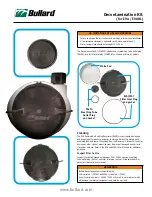
24
Preparing for Use
G1 Powered Air-Purifying Respirator (PAPR)
US
6.7
Installing Air Filtration Cartridges/Canisters
WARNING!
Use this respirator with the correct air filtration cartridge/canister for protection against specific
chemical or particulate contaminants. Do NOT use this device if you cannot make sure that the air
filtration cartridge/canister is applicable for the contaminant. The respirator will not supply protec-
tion unless all inhaled air is pulled through an applicable air filtration cartridge/canister.
Do NOT use an air filtration cartridge/canister with an expired shelf life.
Do NOT use the air filtration cartridge/canister if the packaging is opened, damaged, or missing.
Make sure that the air filtration cartridge/canister is in its original packaging before use in a contam-
inated environment.
Do NOT use air filtration cartridges/canisters more than one time. Replace air filtration cartridges/
canisters after each use.
Do NOT replace the air filtration cartridges/canisters in a contaminated area.
Obey the decontamination and disposal procedures set by the applicable authorities.
Do NOT use a respirator if the gaskets are damaged or missing from the blower assembly.
Do NOT tighten the cartridges/canisters too much. Doing so can cause damage to the gasket. If
the gasket is damaged, leakage and exposure to contaminants can occur.
When used at specified occupational exposure limits, do NOT exceed the rated service time of the
air filtration cartridge/canister.
Failure to obey these warnings can result in serious injury or death.
Install two new MSA air filtration cartridges/canisters of the same type and part number before each
use.
Use only approved cartridges/canisters. For information about approved configurations, refer to the
G1 PAPR Approval Insert (PN 10192481).
(6) Put the blower assembly on a flat surface in an upright
position so the airflow indicator is vertical on top of the
blower assembly.
(7) Move the power switch to the "ON" position.
(8) Make sure that the device operates correctly.
(9) Make sure that the red ball goes to the top of the
airflow indicator. If it does not, do the following:
a) Replace the battery with a new single-use (Li-SO
2
)
or fully charged rechargeable (NiMH) battery, and
do an airflow test again.
b) If the airflow test is unsatisfactory, replace the
blower assembly, and do an airflow test again.
c) If the airflow test is unsatisfactory, remove the
respirator from service.
(10) Move the power switch to the "OFF" position.
(11) Remove the airflow indicator.















































